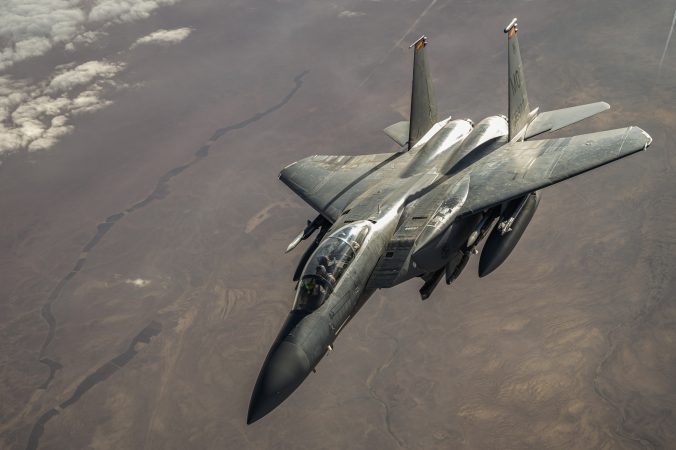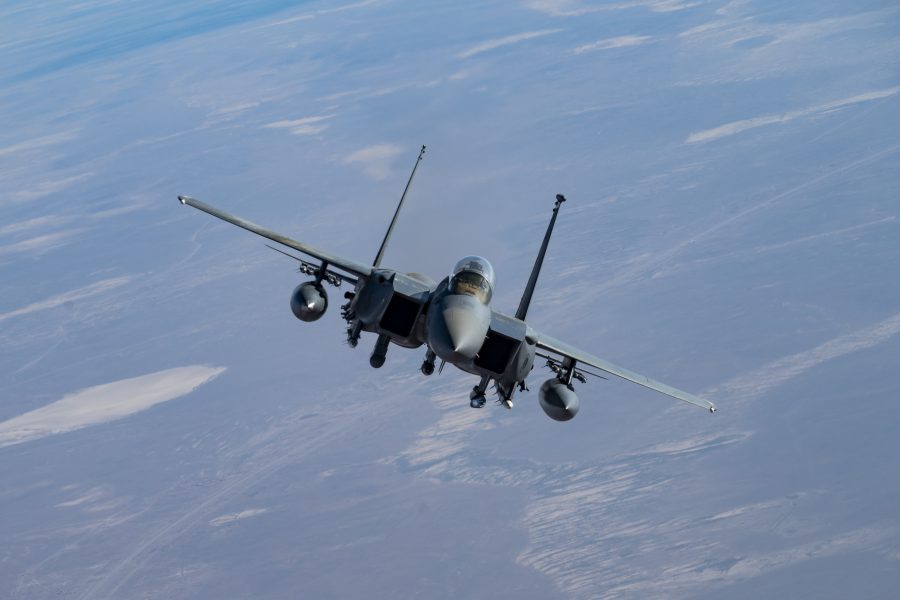More of the U.S. Air Force fighters directed to deploy to the Middle East late last month arrived as Israel contemplates its response to Tehran’s ballistic missile attack on Israel on Oct. 1. A squadron of F-15E Strike Eagles began arriving in the region Oct. 9, U.S. Central Command announced.
The Biden administration ordered more airpower to the region following Israel’s killing of Lebanese Hezbollah’s leader Hassan Nasrallah. Iran retaliated with a salvo of some 180 ballistic missiles launched at Israel—many aimed at Israeli Air Force bases—that were mostly intercepted, according to Israeli and American officials.
Now, Israel is weighing its response and is likely to conduct some form of airstrike against Iran. The Biden administration is seeking to avert a full-scale regional war.
President Joe Biden has said the U.S. would not support an attack on Iran’s nuclear or oil facilities, but the White House and Pentagon have made clear the U.S. will come to Israel’s defense if attacked.
Israeli Defense Minister Yoav Gallant had been scheduled to meet with Secretary of Defense Lloyd J. Austin III at the Pentagon on Oct. 9, but his visit has been deferred until after Israeli prime minister Benjamin Netanyahu talks by phone with Biden.
“We still continue to consult with the Israelis on what their response might be,” Deputy Pentagon Press Secretary Sabrina Singh told reporters Oct. 8.
After Nasrallah’s killing, the Pentagon ordered three more USAF fighter and attack aircraft squadrons to the region: additional units of F-15Es, F-16s, and A-10s.
The fresh Strike Eagles deploying to the Middle East are from Mountain Home Air Force Base, Idaho, Air & Space Forces Magazine first reported. CENTCOM later announced the move. The first batch of aircraft made their way across the Atlantic and stopped at RAF Lakenheath, U.K., where they were spotted on Oct. 7 by local observers.

The F-15Es—following similar deployments from the continental United States—must then cross the Mediterranean Sea. The fighters are being supported by USAF aerial refueling tankers, open-source flight tracking data shows. It is unclear if all the F-15Es have arrived in the Middle East as fighter squadrons typically do not land at their forward air base all at once.
The U.S. is planning to extend the deployment of current aircraft units in the Middle East to increase the overall number of fighters and attack aircraft in the region, essentially doubling the fourth-generation aircraft footprint. The U.S. already has F-22 fifth-generation air superiority fighters in the Middle East, and the Raptors will continue their deployment as scheduled.
The Pentagon is overlapping the deployments of incoming and outgoing F-15E, F-16, and A-10 units for a temporary boost in the region. The additional A-10s arrived roughly 10 days ago. The U.S. also conducted such a move following Hamas’ Oct. 7 attack on Israel and in April before Iran attacked Israel.
F-15Es from the 335th Fighter Squadron at Seymour Johnson Air Force Base, N.C., first deployed to the region in April of this year, and soon after they got to the Middle East, those planes, along with U.S. Air Force F-16s and coalition warplanes, helped shoot down 80 Iranian drones during a previous attack by Iran on Israel on April 13.
The F-15Es from Seymour Johnson currently in the Middle East will stay in the region for now as part of Austin’s decision to delay the redeployment of current assets to enhance U.S. force posture in the region, a U.S. official told Air & Space Forces Magazine.
U.S. warplanes were ready to assist Israel by shooting down drones or cruise missiles on Oct. 1, a person familiar with the matter said, but U.S. aircraft were not needed as Iran launched nearly 200 ballistic missiles, which fighters cannot defend against. Two U.S. destroyers fired a dozen interceptors at Iranian ballistic missiles.
In addition to land-based airpower, the U.S. is keeping the USS Abraham Lincoln aircraft carrier strike group, which carries F-35C Lightning II and F/A-18E/F Super Hornet fighters, in the Middle East. The USS Harry S. Truman aircraft carrier deployed last month from Virginia and is expected to head to the Mediterranean Sea. The USS Wasp, an amphibious assault ship that carries AV-8 Harrier attack planes, V-22 Ospreys tiltrotor aircraft, and some 2,200 Marines and Sailors from the 24th Marine Expeditionary Unit, is operating in the Eastern Mediterranean.
“Our assessment is that this conflict still remains contained, and we are doing everything from our perspective to ensure that it does remain contained, and that the message of deterrence is still sent far and wide,” Singh said. “That’s why you’ve seen us rotate out different carriers through the region. We still have the ARG/MEU in the Eastern Mediterranean. We have flown in different capabilities. We have a lot of power in the region. And we will use that, if needed, to protect U.S. forces. And should we see another attack from Iran, we will also come to the defense of Israel.”
